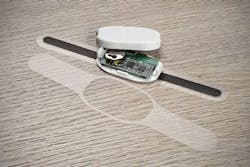Biodegradable ECG Patch Paves the Way to a More Sustainable Medical Industry
What you’ll learn:
- Why we need to replace single use devices with sustainable alternatives.
- How does the sustainable ECG patch work?
In 2019 alone, people discarded 53 metric tons of electronic waste. Replacing fossil-based materials with sustainable alternatives is one of the key challenges if we’re to shrink the carbon footprint of electronic equipment. Reducing single-use devices with modular designs consisting of reusable and recyclable—or even biodegradable—parts is critical in reaching that goal.
Why would we throw away precious minerals because the whole device can’t be reused? At the same time, these new materials need to have performance comparable to the materials they replace.
We set out to develop modular, nanocellulose-based materials to replace a particular segment of this development—adhesive electronic equipment for medical use. For this purpose, the adhesive patch used for electrocardiography (ECG) is the best place to start, because the mission is to recreate a technology that the medical industry has spent decades perfecting for its purpose, into a modular, biodegradable packaging. It’s an example of a technology where hitting that sweet spot between reliability and sustainability is critical for long-term success.
Cardiac disease is the number one cause of death in both the United States and the EU, and the ECG is the easiest and most popular way to monitor cardiovascular health. It’s used to record the heart’s electrical signal to monitor circulatory health and the condition of the heart. Electrodes attached to the skin with an adhesive plastic patch communicate the ECG trace to a receiver, showing the electrical activity in a patient’s heart.
Traditional ECG Patches
These ECG patches are essential to modern medical treatment. That’s because an ECG is easy to conduct, and the required technology is widely available. From an economic perspective, the global ECG patch and Holter monitor market was valued at US$1.2bn in 2022, and it’s expected to grow at an annual rate of 20% from 2023 to 2030.
Traditional ECG patches combine Ag/AgCl-electrodes with a conductive gel, held together by a plastic film. At least three electrodes need to be placed on the patient’s skin to create an ECG lead vector across the heart, meaning at least three disposable patches are used per patient.
By measuring cardiac electrical activity in different areas of the circulatory system, medical professionals can assess the level of functionality in different parts of the heart and recommend treatment if discrepancies are found.
Dealing with Patch Waste
Because of the non-modular and non-biodegradable nature of current technology, ECG patches are disposed of as medical waste after every use. Consequently, these patches represent one of the most common sources of medical waste. While this equipment is critical for healthcare services, such single-use technology can’t be the market standard if the medical industry is to become sustainable in the long term.
Medical waste is a large and growing issue. According to the AMA Journal of Ethics, 8% of U.S. climate gas emissions come from healthcare. In terms of plastic waste, American hospitals generate up to 6 million tons of waste annually.
Because medical waste is considered hazardous, almost no single-use equipment can be recycled, meaning it goes straight to disposal, most commonly by incineration. Thus, the production of single-use technology stays high, while used equipment contributes to climate emissions and potential environmental challenges related to waste disposal.
Although every healthcare development helps us stay alive and healthy longer, new and more advanced single-use equipment puts a further burden on the planet. To deal with this serious and increasing problem, we need to incorporate more biodegradable materials and modular builds into this type of medical technology.
Nanocellulose-Based Biodegradable ECG Patch
The solution lies in the use of more biodegradable, cellulose-based materials. Using the same nanocellulose film used to produce cellulose e-skin, we created a fully biodegradable ECG patch (see figure).
The disposable patch and adhesive are made from nanocellulose, while carbon conductors and sensing electrodes—parts of the ECG patch that were previously sent for incineration—can be dismantled and recycled. The electronic components could easily be reused with a new skin patch, while the used patch is fully biodegradable.
Using this technology leads to zero plastic waste from ECG, and full recyclability of finite mineral components. Operationally, it’s as reliable to use as the traditional patch.
In our technology, the skin patch, which is the disposable part, is not only biodegradable and made from sustainable green material, it also benefits from its unique design that removes the need for conventional metallic connectors to the ECG electronics. This is an important feature, enabling the skin patch to remain purely cellulose-based with printed carbon.
In other modular devices in the market, the disposable patch consists of mixed materials, such as metal, plastic, epoxy glue, etc. As a result, they become mixed waste after use.
Modular Skin Applications Beyond the ECG Patch
Having established that the concept works, its application isn’t limited to ECG patches. Flexible, easy-to-use, modular skins like the one implemented with this ECG patch could be used for several other applications in the future. Having this proof of concept opens doors to new innovations that further build toward a sustainable future for electronic technology.
With the EU Commission's Circular Economy Action Plan and other sustainability legislation in the pipeline, manufacturers of electronics will have to start producing sustainable options to the technologies that medical professionals have relied on and perfected for decades.
The biodegradable ECG patch has shown to be a reliable alternative to a proven technology, paving the way for other applications of the same technology in other single-use adhesive patches and healthcare measurement technologies.
Designing new technical solutions for industries that rely heavily on single-use equipment is a necessity. This application of nanocellulose skin has the potential to provide sustainable alternatives for many of these vital, yet unsustainable pieces of technology.

